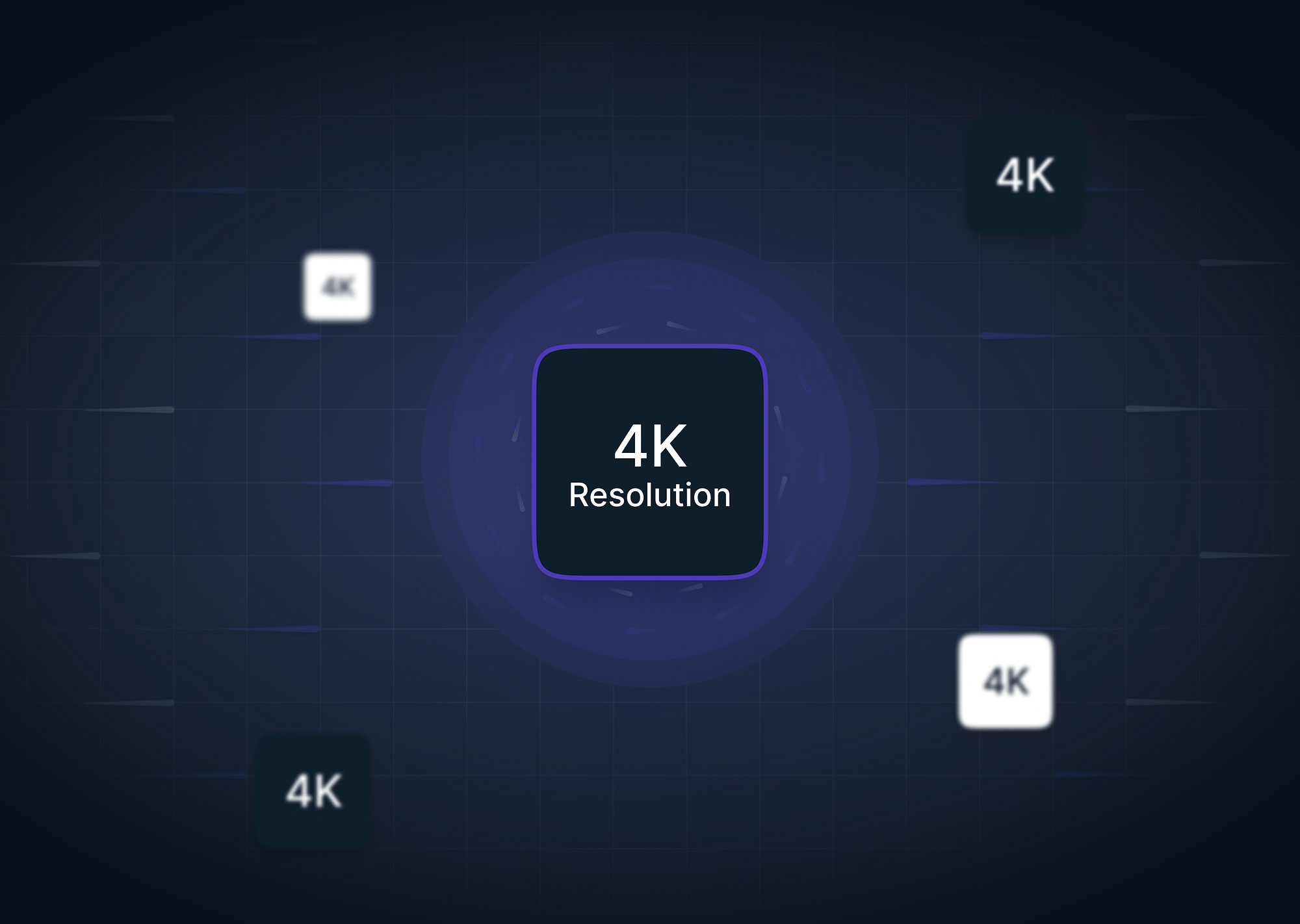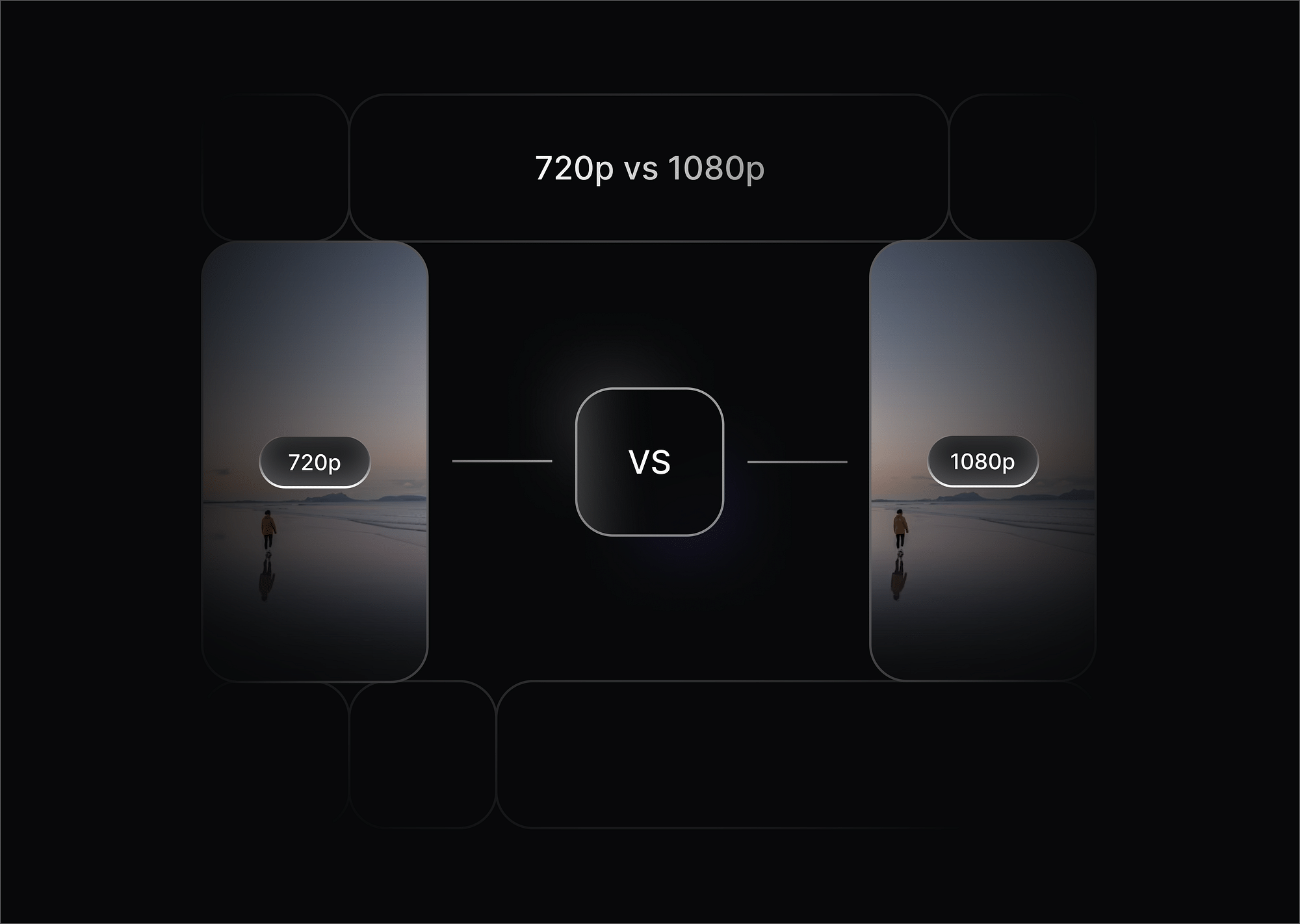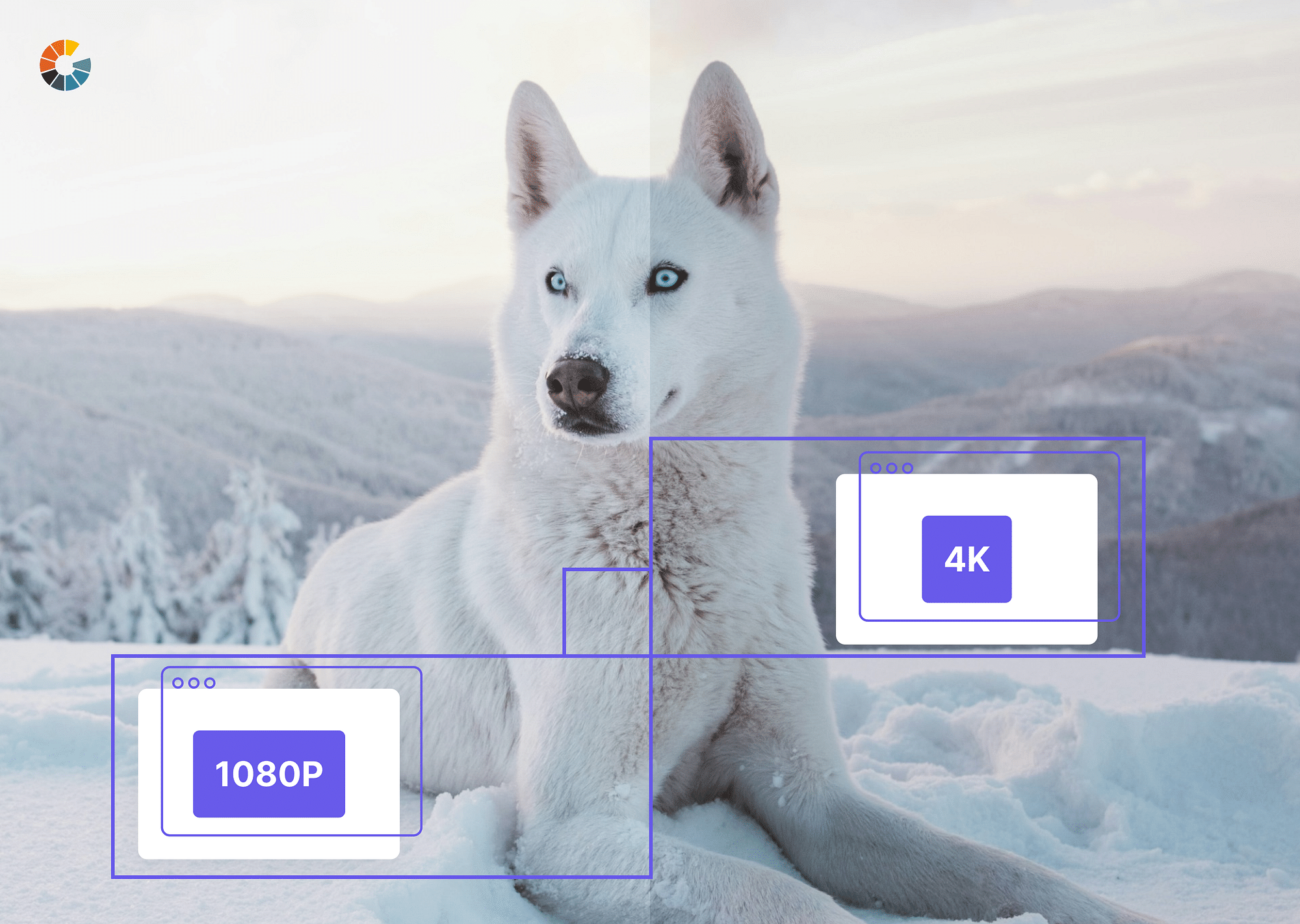The rise of 4K resolution has revolutionized how we view digital content, providing a level of clarity and detail never seen before. As more devices adopt 4K, understanding its fundamentals is essential. This guide breaks down everything you need to know about 4K video resolution, from its pixel count to its advantages, comparisons with other resolutions, and what the future holds.
What is 4K Resolution?
4K resolution is a display technology that delivers an ultra-high-definition viewing experience by featuring approximately 4,000 horizontal pixels. This resolution is the current benchmark for premium visual quality, and it’s commonly found in modern televisions, monitors, projectors, and cameras. If you're wondering "what is 4K resolution?" the answer lies in its ability to showcase more detailed and sharper images due to its high pixel density. Let’s break down the technical details:
Pixel Count
At its core, 4K resolution features 3840x2160 pixels, which results in a total of 8.3 million pixels on the screen. Compared to Full HD (1080p), which only has about 2 million pixels, 4K delivers four times the number of pixels, ensuring a much higher level of detail. This increased pixel count reduces visible pixelation, allowing for clearer images even when viewed up close. Whether you are watching a movie, playing a game, or browsing through photos, the difference in clarity is noticeable, especially on larger screens.
Aspect Ratio
The aspect ratio of 4K is typically 16:9, which is the same as HD and Full HD, ensuring compatibility with widescreen content. This ratio is standard for most modern displays, from televisions to computer monitors, making it ideal for watching movies, streaming shows, and playing video games. However, certain 4K resolutions, such as those used in professional filmmaking, may vary. For example, 4096x2160 pixels is often referred to as true 4K or DCI 4K (Digital Cinema Initiatives), and it has a slightly wider aspect ratio of 17:9, making it more suitable for cinematic experiences.
Dimensions
When discussing 4K resolution dimensions, it’s important to note that the term "2160p" is often used interchangeably with 4K. This naming convention refers to the 2160 vertical pixels. The letter "p" stands for progressive scan, a display method that draws all lines in sequence, providing a smoother image compared to older technologies. These dimensions make 4K resolution optimal for larger screens, as the pixel density ensures crisp images without losing quality, even on 55-inch or 65-inch displays.
Clarity and Depth
The clarity of 4K resolution is unmatched when it comes to consumer-grade displays. Thanks to the higher pixel count, the images look more detailed and immersive, with less visible pixel structure, even when viewed at closer distances. This makes 4K an excellent choice for large-screen TVs and monitors, where lower resolutions might result in blurred edges or pixelation. Additionally, 4K resolution brings enhanced depth perception, creating a more three-dimensional feel to images and videos, which is especially noticeable in nature documentaries, sports broadcasts, and action movies.
Common Applications of 4K
Here are some of the most common applications of 4k resolutions these days:
- Television & Streaming: Many streaming platforms, like Netflix, Amazon Prime, and YouTube, now offer 4K content for a more immersive viewing experience.
- Gaming: Gaming consoles like the PlayStation 5 and Xbox Series X support 4K gaming, providing gamers with detailed environments and lifelike characters.
- Cinematography: Professional filmmakers have embraced 4K for its high-quality visuals, ensuring that even the smallest details are captured in each frame.
- Monitors & Productivity: For professionals working in design, video editing, or even general productivity, 4K monitors allow for higher detail and more screen real estate, which can enhance workflow efficiency.
In essence, 4K resolution size offers a staggering number of pixels, an ideal aspect ratio for widescreen viewing, and is available in various dimensions to suit everything from cinema to home entertainment. Its widespread adoption means it has become a standard for high-definition content, providing a much sharper and more immersive experience compared to older resolutions like 1080p and 720p.
Brief History of 4K Adoption
The adoption of 4K resolution has been a gradual process, marked by early experimentation in professional filmmaking and eventual mainstream success. The journey began with early adopters in the film industry, who recognized the potential of 4K for delivering stunning, high-definition visuals. As with any new technology, there were significant challenges in the early stages, but over time, 4K evolved to become a household standard.
Early Adopters
Filmmakers were the pioneers of 4K technology. The cinematic world has always been driven by the need for higher clarity and detail, and 4K was the perfect solution to capture intricate visuals on the big screen. Directors and cinematographers saw the immense benefits of shooting in 4K, as it allowed for crisper images, better color depth, and the ability to reframe shots without losing quality. By the late 2000s, leading production companies began using 4K cameras for blockbuster films, setting the stage for wider adoption.
Challenges
Despite its promise, 4K faced numerous challenges during its early years:
- High Costs: The production and broadcasting of 4K content were prohibitively expensive. Cameras, storage systems, and editing tools needed to handle the massive file sizes and bandwidth requirements were costly, limiting 4K use to high-budget productions.
- Limited Content: Initially, there was a scarcity of 4K content. While some films were shot in 4K, most consumers did not have access to compatible devices, and streaming platforms were slow to adopt the technology due to bandwidth limitations.
- Compatibility: Early 4K adoption was also hindered by the lack of widespread support from consumer electronics. Televisions, monitors, and projectors capable of displaying 4K content were rare and expensive, making it difficult for the average consumer to experience the full potential of 4K.
Growth and Mainstream Adoption
As technology advanced, the costs of producing and consuming 4K content began to decrease. 4K cameras became more affordable, and streaming platforms like Netflix, YouTube, and Amazon Prime Video started offering 4K content as internet speeds and bandwidth capabilities improved globally. This was a pivotal moment, as it allowed consumers to stream high-definition content from the comfort of their homes, making 4K accessible to a broader audience.
At the same time, television manufacturers began producing more affordable 4K TVs, and the gaming industry followed suit with 4K-capable consoles like the PlayStation 4 Pro, PlayStation 5, and Xbox Series X. As more devices adopted 4K technology, the resolution became a standard for high-end displays.
Today, 4K is no longer a niche technology; it is the default resolution for most modern TVs, streaming devices, gaming consoles, and even smartphones. As internet speeds continue to improve and more content is produced in 4K, the resolution has firmly established itself in mainstream consumer technology.
The journey of 4K from a high-end professional tool to a household staple is a testament to how rapidly technology can evolve when both content producers and consumers see its value.
Advantages & Disadvantages of 4K Resolution
4K resolution has become a popular choice for those seeking high-quality visual experiences. Its sharper images and vibrant colors make it ideal for modern entertainment and professional use. However, like any technology, it comes with its set of pros and cons. Here’s a look at the key advantages and disadvantages of 4K resolution size:
Advantages:
- Sharper Image: With 4K resolution pixels, the display delivers stunning clarity and finer details, providing a more lifelike image. The higher pixel density ensures crisp visuals, even on large screens.
- Better Color Depth: The increased pixel count allows for better color depth, making colors look more vibrant, accurate, and rich. This enhancement is particularly noticeable in scenes with subtle color gradations or fast motion.
- Immersive Experience: Ideal for large screens, 4K video size ensures an immersive viewing experience. Even when viewed from close distances, there’s no visible pixelation, making it perfect for home theaters and gaming setups.
Disadvantages:
- Content Availability: Although growing, not all content is available in 4K resolution. Many streaming platforms and cable providers still offer limited 4K content, and older devices may not support the resolution, requiring upgrades.
- File Size: 4K video size is significantly larger than lower resolutions like 1080p. This requires more storage space and higher bandwidth for streaming, which can be a challenge for users with limited internet speeds or data caps.
- Price: 4K TVs and monitors tend to be more expensive compared to their lower-resolution counterparts. The cost of entry for a good-quality 4K setup, including compatible devices, can be higher, which may deter budget-conscious consumers.
While 4K resolution offers an unparalleled viewing experience, it’s essential to weigh these advantages and disadvantages based on your needs and available resources.
Comparison with other resolutions
While 4K resolution has become the gold standard for high-quality displays, it’s essential to understand how it compares to other popular resolutions like 1080p, 720p, 1440p, and even 8K. Below, we break down the key differences between 4K resolution size and these other resolutions.
4K vs 1080p
| Feature | 4K | 1080p |
|---|---|---|
| Resolution | 3840x2160 | 1920x1080 |
| Pixel Count | 8.3 million pixels | 2.1 million pixels |
| Aspect Ratio | 16:9 | 16:9 |
4K resolution offers four times the pixel count of 1080p, resulting in significantly sharper and clearer images, especially on larger screens. The increase in pixels provides more detail and greater depth, making it ideal for high-quality content like movies, games, and streaming shows. However, on smaller displays, the difference between 4K and 1080p may not be as noticeable unless you're sitting very close to the screen.
Check out this blog for detailed comparison: 4k vs 1080p
4K vs HD (720p)
| Feature | 4K | 720p |
|---|---|---|
| Resolution | 3840x2160 | 1280x720 |
| Pixel Count | 8.3 million pixels | 921,600 pixels |
| Aspect Ratio | 16:9 | 16:9 |
When comparing 4K to HD (720p), the difference is even more dramatic. 4K resolution has more than 11 times the number of pixels compared to 720p, providing much higher clarity, depth, and sharpness. For modern large-screen televisions, 720p often appears pixelated and less defined, making 4K a far superior option for anyone who values picture quality. While 720p was once the standard for HD content, it has now become outdated, especially when compared to 4K.
4K vs 1440p (QHD)
| Feature | 4K | 1440p (QHD) |
|---|---|---|
| Resolution | 3840x2160 | 2560x1440 |
| Pixel Count | 8.3 million pixels | 3.7 million pixels |
| Aspect Ratio | 16:9 | 16:9 |
1440p, also known as QHD (Quad HD), sits between 1080p and 4K in terms of resolution. While it offers a noticeable improvement over 1080p, it doesn’t reach the same level of detail provided by 4K. However, 1440p is often favored by gamers because it strikes a balance between image quality and performance—particularly for gaming hardware that may struggle to handle 4K. On a standard television or monitor, though, the difference between 1440p and 4K becomes apparent, with 4K offering a more immersive viewing experience.
4K vs 8K
| Feature | 4K | 8K |
|---|---|---|
| Resolution | 3840x2160 | 7680x4320 |
| Pixel Count | 8.3 million pixels | 33.2 million pixels |
| Aspect Ratio | 16:9 | 16:9 |
8K resolution is the next step up from 4K, boasting four times the pixel count, with 33.2 million pixels. While 8K delivers unparalleled sharpness and detail, there are several factors to consider. First, 8K content is still extremely limited, meaning most users won’t find much native 8K material to watch. Secondly, the human eye struggles to distinguish the difference between 4K and 8K on smaller screens (under 65 inches), making the upgrade less impactful unless viewed on a large display or projector. For now, 4K remains the more practical and accessible option for most users.
Summary of Resolution Comparisons:
- 4K vs 1080p: Four times the resolution, making 4K much sharper on larger screens.
- 4K vs HD (720p): Over 11 times the pixels, providing vastly superior clarity and detail.
- 4K vs 1440p (QHD): 4K delivers better visuals, but 1440p is popular among gamers for better performance on gaming hardware.
- 4K vs 8K: 8K is sharper, but content is limited, and the difference may not be visible on smaller displays.
As you can see, each resolution serves a different purpose depending on the device, screen size, and usage scenario. For those looking for the best all-around visual experience, 4K resolution size strikes the perfect balance between clarity, content availability, and device compatibility.
Future Trends in 4K
As technology continues to evolve, so does 4K resolution. Here’s what we can expect for the future:
- AR & VR: 4K is expected to play a significant role in improving the clarity and realism of augmented and virtual reality experiences.
- AI-Powered Enhancements: Artificial intelligence is enhancing video resolution with upscaling techniques, turning HD content into near-4K quality.
- 8K and Beyond: While 8K is already here, it remains a niche. Over time, it may become as common as 4K is today.
- 360-Degree Videos: The growing demand for immersive 360-degree content is pushing the boundaries of 4K to create richer, more interactive experiences.
- Interactive Content: As streaming and gaming platforms evolve, 4K will become a standard for interactive and dynamic video content.
Concluding Remarks
4K resolution has transformed the way we experience video, offering unparalleled sharpness and detail. While 4K is quickly becoming the norm, the journey from early adoption to mainstream use has been fascinating. With future trends like AR, VR, and AI-driven enhancements on the horizon, the future of 4K and beyond looks bright.
By understanding 4K’s capabilities and benefits, you'll be better equipped to make decisions about upgrading your viewing experience. Whether it's for gaming, movies, or just enjoying crystal-clear images, 4K is here to stay!
FAQs
1. Is 4K and UHD resolution the same?
Yes, 4K and UHD are often used interchangeably. However, UHD technically refers to a resolution of 3840x2160, while true 4K (used in cinema) has a slightly higher resolution of 4096x2160.
2. What is true 4k resolution?
True 4K resolution, primarily used in the film industry, is 4096x2160.
3. Which is better, UHD or 4K?
The terms are used interchangeably in most consumer technology. However, 4K refers to the resolution used in cinema, which has a slightly higher pixel count than UHD.
4. What is the downside of a 4K TV?
The primary downside is content availability. While 4K is becoming more common, much content is still produced in lower resolutions. 4K devices also tend to be more expensive, and streaming 4K requires more bandwidth.
5. Is 4K the highest quality?
No, 8K is currently the highest resolution commercially available, but 4K remains the most widely adopted high resolution for most devices.
6. Blu-Ray vs. 4K: Is Blu-ray better than 4K?
4K Blu-ray discs offer better quality than standard Blu-ray, primarily because of higher resolution, better color depth, and support for HDR. Blu-ray at 1080p is still excellent, but 4K provides a superior viewing experience.




